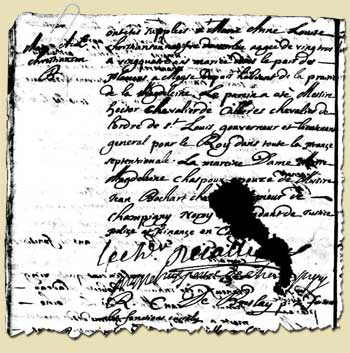Back Home.
Return to La Prairie.
Louis Hector de Callière, Governor General of New France (1698 – 1703) acted to clamp down on illegal trade at the behest of King Louis XIV who expressed concern about falling prices for beaver pelts. Outposts were closed in the west and licenses were suppressed. Callière confiscated trade goods from Montréal merchants who supplied the traders and imprisoned a commander at one of the outlying forts for trafficking. Soon the coureurs de bois began to return to the fold.
Among them were Moïse and Anna who moved to LaPrairie by July 1699 with two children in tow, Charles and our ancestor Marie-Angélique. They were home prior to the death of his mother Georgette on 24 January 1700.
As stated previously, no other mention is found of their son Jean-Baptiste beyond his 1696 baptism. Oddly according to Charles' death record he was 54 when he died in 1750 implying he was born about 1696 (which was Jean-Baptiste's birth year).
Our ancestor Marie-Angélique was born about 1699. No birth records have been found for either her or Charles. Neither child's baptism is mentioned in the Reformed Dutch Church of Albany, nor were they re-baptized in LaPrairie so it is possible they were baptized by a Catholic priest while the family still resided south of LaPrairie, perhaps in the area of Champlain according to some researchers. It would be interesting to know if Jean-Baptiste was in fact Charles and renamed in a Catholic christening when his sister was baptized. Their mother did undergo such a name change.

Anne's Baptism.
Since 1627, colonists sent to New France were expected to practice the Catholic faith. The Huguenots proved to be too resistant to rule by French kings so this was a measure to reduce their threat to the sovereign. Anna, an erstwhile member of the Reformed Dutch Church, was baptized as Marie Anne Louise Christiansen in Notre-Dame-de-Montréal on 12 July 1699. Her parents were not named, only that she had married dans le pays de la Flamonds.
Perhaps because Moïse's father had established himself as a gentleman farmer, or because Moïse's business dealings in Corlaer were not quite so nefarious, or maybe owing to his making a fortune there, an enviable line-up of distinguished persons stood as witnesses. Anne's parraine (godfather) was none other than Monsieur Louis-Hector de Callière, chevalier, captain in France, governor of Montréal, governor general of New France, knight of the order of Saint-Louis – the very man who was cracking down on the coureur de bois. Her maraine (godmother) was Dame Marie-Magdeleine Chapoux, wife of Jean Bochart de Champigny, Sieur de Noroy et de Verneuil, chevalier, Intendant of New France.
Compensation Paid.
Further adding to Anna's intrigue is a listing within New England captives carried to Canada between 1677 and 1760 of the name Marie Louise Christancien (the name she took when she was baptized) "living at LaPrairie in 1702". According to this source she had been captured by Indians for which she was compensated 60 livres. But when did she meet this fate? The record does not say leaving one to speculate of a time between 1675 (her birth) and her marriage in Albany in 1697. It did not occur during the February 1690 Schenectady Massacre for Peter Schuyler gave this account: "But ye Snow was so Extream Deep yet it was impossible for any woman to march a mile. So yet they took none but men and boys that could march."
Citizenship.
After the death of François around 1707, Moïse inherited a third of his father's farm along the Saint-Jacques River in LaPrairie. There was more than enough land to grow crops for his family as well as to produce enough surplus to send to the markets in the cities. The family name appears on a plot map of this period in LaPrairie.
Anna became a citizen of New France on 10 May 1710. Though it would cost the couple as much as 100 livres, it was a prudent step. Without citizenship, she would not be allowed to inherit property, and the family lands would revert to the king if her husband predeceased her:
Moïse Dupuy received a concession in the seigneurie de La Prairie-de-la-Madeleine at la Côte Saint-Joseph on 16 mars 1717.
Closing A Chapter.
Moïse and Anna celebrated the weddings of their children over the next decades. Two of their daughters are our ancestors: Marie-Angélique, their oldest daughter, married Guillaume Beaudin on 11 January 1722 and Barbe, their youngest, married Paul Lériger de LaPlante on 17 November 1733. Guillaume's brother Michel Baudin married their sister Marie-Francoise in 1725.
Moïse served as sexton in the church often standing as a witness to events in the church of LaPrairie. He was present at the burial of our ancestor Anne Leper, wife of François Pinsonnault on 30 Jan 1732.
In 1750 there was death. Moïse, 76, died on 19 January. Son Charles, 54, died on 26 January. Daughter-in-law Marie-Anne Roy, wife of François, died on 23 January and her infant daughter on the 25th. Our ancestor Barbe, 34, passed on 30 January. Her three year old son Clément died 26 May and 12 year old daughter Marie-Catherine four days later. Our ancestor Jacques Boutin died there 9 May. And Anne, the girl from Corlaer, at age 75, was lost on 26 October.
Use the right sidebar links to navigate to our ancestors Marie-Angelique or Barbe's pages.
- Jetté, René, Dictionnaire généalogique des familles du Quebec des origines à 1730, Montreal: Les Presses de l'Universite de Montreal, 1983
- New England Captives Carried to Canada Between 1677 and 1760 During the French and Indian Wars; Coleman, Emma Lewis; Portland, Maine 1925, Volume One, pp.121-124.
- The treaty of Montreal signed in 1701 was known as the Great Peace, Anne was baptized in Montréal in 1699
- Notre-Dame de Montréal, 1699
- La-Nativité-de-la-Bienheureuse-Vierge-Marie-de-Laprairie, 1750, page 268
- Bulletin des recherches historiques, (XXX), no. 8, 225-232 and Je Me Souviens, (Winter 1984):49
